The Milky Way like you’ve NEVER seen it before: Scientists unveil the most detailed infrared map of our Milky Way yet – showing 1.5 billion moons, stars and planets in unprecedented detail
From the violent births of newborn stars to the hidden mysteries of the galactic core, these new images show the Milky Way like you’ve never seen it before.
After 13 years of observations, scientists have now unveiled the most detailed map of our Milky Way ever created.
Using infrared light, astronomers from the European Southern Observatory (ESO) peered through the dust and gas that normally obscures the center of the Milky Way.
Their vast survey shows 1.5 billion moons, stars and planets covering an area of the sky equivalent to 8,600 full moons.
Lead researcher Dante Minniti of the Universidad Andrés Bello in Chile said: “We have made so many discoveries that we have changed the view of our Milky Way forever.”
Researchers have created the most detailed map of the Milky Way ever, with stunning images of the 1.5 billion stars, planets and moons captured by the study

This latest map covers an area equivalent to 8,600 Full Moons. This diagram shows the area covered by the latest survey covered by the map. The red areas show areas covered by the previous largest observation project
Over 420 nights of observation, ESO’s VISTA telescope scanned the same parts of the sky to build an enormously detailed map of the faintest objects.
The researchers’ efforts have resulted in the largest map of our Milky Way ever created.
This new map, known as the VISTA Variables in the Vía Láctea extended (VVVX), is composed of more than 200,000 individual images taken between 2010 and 2023.
With 1.5 billion objects recorded, the VVVX contains approximately 10 times more objects than the previous largest map released in 2012.
The resulting dataset is so large that it contains 500 terabytes of data – roughly the equivalent of 124,000 high-definition movies.
Images released by the researchers reveal brightly glowing nebulae and huge star clusters.
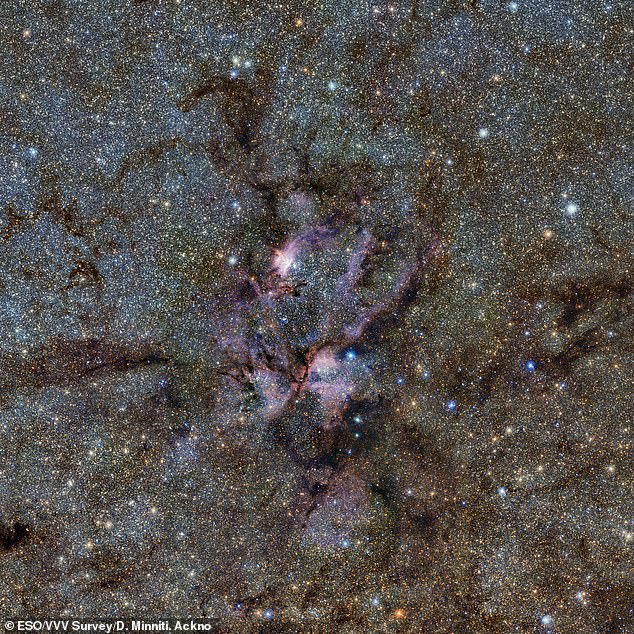
Using an infrared telescope, the researchers were able to observe features such as the formation of new stars. This image shows a stellar nursery called NGC 6357, where hot young stars are forming from gas
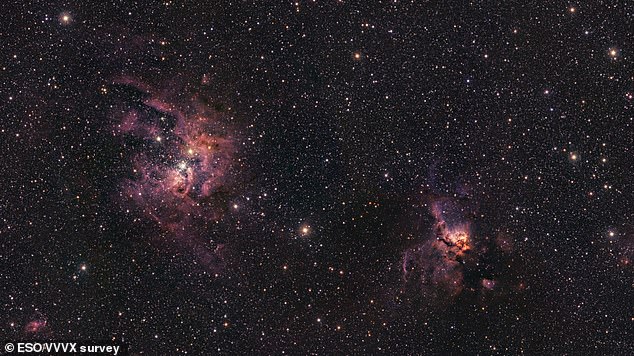
As infrared light passes through gas and dust, these images reveal more details of galactic processes. This image shows a pair of newly formed stars 22,000 and 9,000 light years away from us
In one image, the VVVX captures a pair of beautiful nebulae, named NGC 3603 and NGC 3576, located 22,000 and 9,000 light-years away from Earth, respectively.
Within these distant gas clouds, researchers can see the intense forces that produce new stars.
At the other end of the cosmic spectrum, another image shows Messier 22, a cluster of extremely old stars 10,000 light-years from Earth.
These distant groups of stars are among some of the oldest objects in the Milky Way.
Dr. Minniti told MailOnline that the research also uncovered a number of unknown objects known to researchers as WIT – which stands for ‘What is this?’
While these images are beautiful, the depth and detail of this new map also gives researchers a glimpse into the inner workings of the Milky Way.
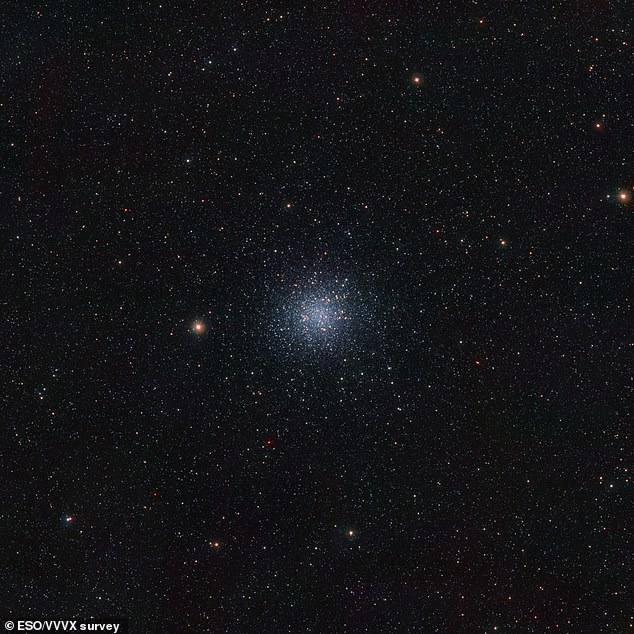
The map also reveals some of the oldest objects in the Milky Way, such as the globular star cluster Messier 22 (pictured), which lies 10,000 light-years from Earth.

These images are not only beautiful, but also provide astronomers with the basis for future research into the most difficult to observe regions of the Milky Way. Pictured: NGC 6188 Firebird Nebula
Dr. Minniti says: ‘We now have a much clearer view of the inner and distant regions of the Milky Way disk, allowing us to understand how our Milky Way is composed and how it has evolved over time.’
The dataset is so large that the researchers have not yet inspected all new discoveries.
However, the team hopes that their observations will lay the foundation for the work of future astronomers.
Co-lead author Dr. Philip Lucas, an astronomer at the University of Hertfordshire, told MailOnline: ‘The map will become the international standard for studying the southern Milky Way in the coming decades.’
The biggest advantage of the new map is that it allows astronomers to look into areas of the Milky Way normally hidden from most telescopes.
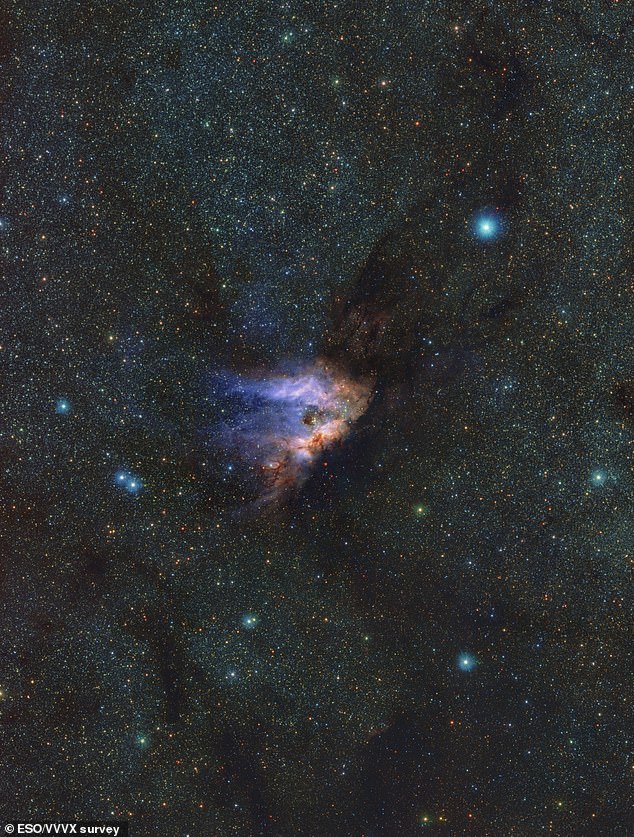
Using infrared light, the researchers can look into the galaxy’s core, which is normally obscured by gas and dust. Pictured: the Omega Nebula, 55,000 light-years from Earth
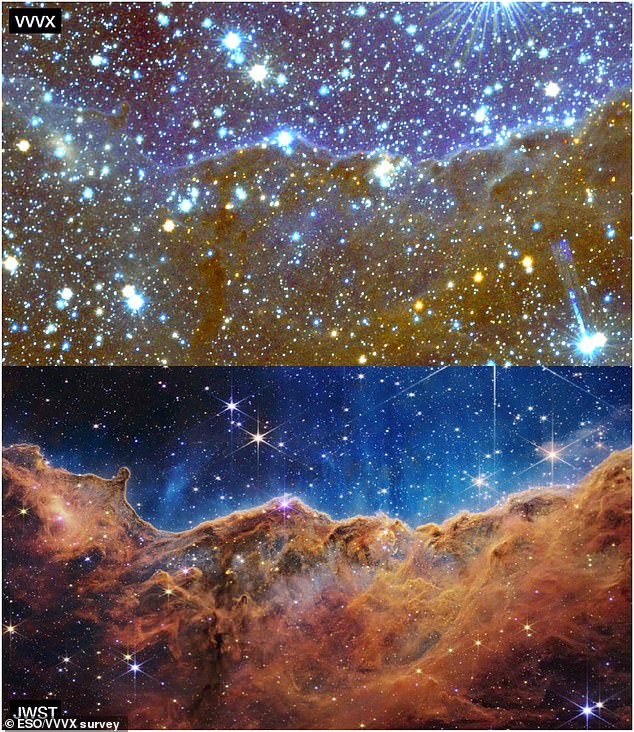
This photo compares an image of the Carina Nebula from the new map (top) with an image taken by the James Webb Space Telescope
Light in the visible spectrum is blocked by the gas and dust clouds that populate the Milky Way, but infrared light passes through these obstacles.
By tracking these objects in the core for such a long time, the researchers were able to map out how they moved and build a 3D map of the innermost regions of the Milky Way.
Dr. Lucas says this will allow researchers to observe objects like a new type of older giant star nicknamed the “old smoker” in ways that weren’t possible before.
These old stars can remain stationary for decades before unexpectedly producing clouds of smoke.
Dr. Lucas says, “Their strange behavior is an old-fashioned astrophysical mystery.”
However, the infrared images from the VVVX map could provide new data about these elusive objects.
Infrared images also allowed the researchers to observe extremely cold objects, such as free-floating planets that do not orbit a star, or burned-out stars called brown dwarfs.
The researchers are now preparing to upgrade the VISTA telescope with new instruments so they can collect more spectral data on the 1.5 billion objects studied.
